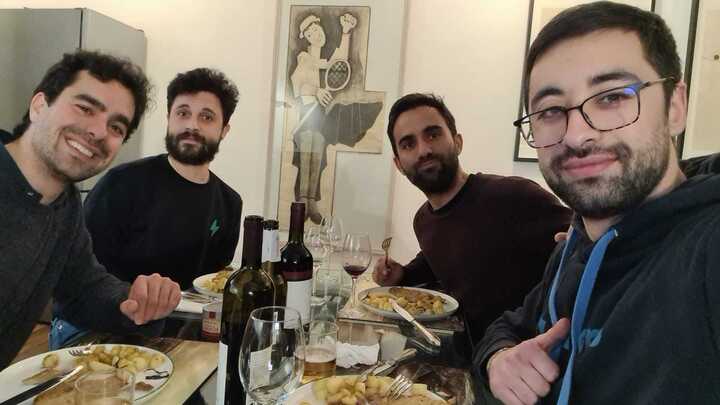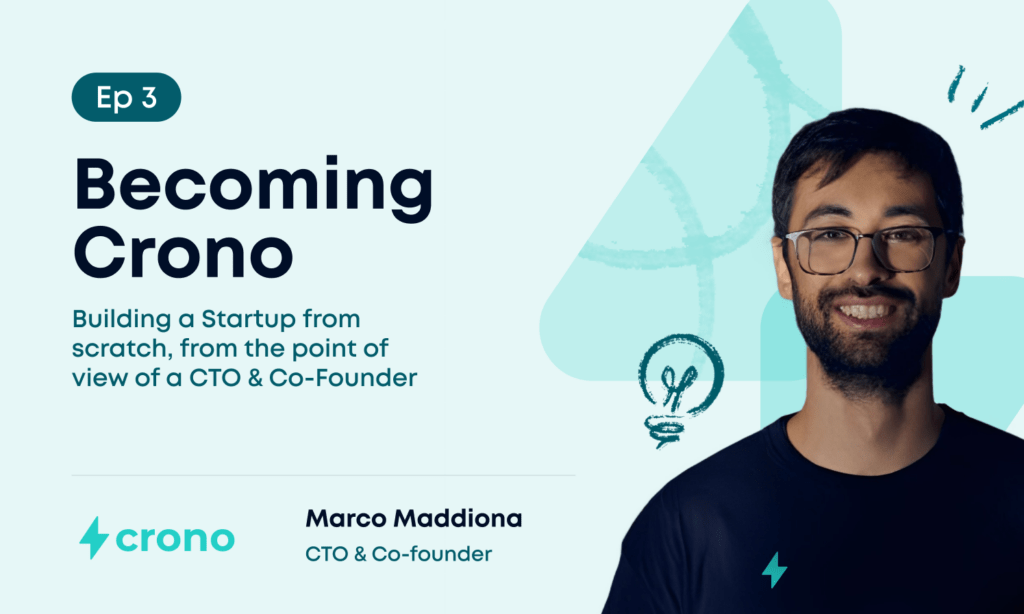The birth and launch of a brand new business is similar to a ride on a roller coaster and that’s one of the many truths uncovered in the startup narrative.
Exciting moments, visiting new places and meeting incredible people but also hard work and constantly improving the product: the adventure told in this column is our story through the eyes of Marco Maddiona, Co-Founder and CTO.
If you’ve already read the previous episodes of Becoming Crono, by now you surely understand the paramount importance of his point of view in a sales and tech start-up environment.
Get ready to discover in this new episode how we managed funding in the middle of a crisis while dealing with our first customers. We’ll cover the very first goal for Crono’s team, showing the importance of rethinking.
Enjoy reading our third episode of Becoming Crono!
Episode 3 - Things we didn’t know we needed (until they became problems)
Hi Croners, I’m Marco Maddiona, CTO & Co-Founder of Crono, welcome to the third episode! In case you have missed the previous ones, head here to read the very start of our adventure. Let’s get back to where we left.
As soon as we returned from WebSummit in Lisbon, we were so enthusiastic that we continued working non-stop: the goal printed in our heads was to close the first investment round (pre-seed) by December 2022.
We were quite confident about the potential of Crono. We would present ourselves to investors proposing our vision and telling them what we had managed to achieve after only two months from the product launch.
However, we soon realised that no matter how positively impressed they were with the team and the maturity of the product, no one was initially eager to invest in us. They were all asking for a little more substantial sales numbers and, above all, they were hinting that we were overvalued.
It was starting to get quite frustrating for us: in our plans, it was not yet time to scale up sales, as we were in the process of requesting funds to accelerate product development, structure the company and then try to conquer the market.
After all, this would be the benefit that investors should bring to a start-up seeking a pre-seed round: unfortunately, not everyone seemed to understand this and preferred instead to wait to invest until they felt more secure.
Comparing ourselves with other start-ups, we realised that we were not the only ones in this limbo and understood that the ensuing crisis was the cause of a strong cooling in start-up investments right from September 2022.
Valuations that one year earlier were normal for startups without MVP became absurd for those who already had a product and even customers.
The timing was not on our side but, once again, we did not lose hope. We realised that we had to adopt a different strategy and, while trying to figure it out, we went back to focusing on our product and sales.
In the meantime, we continued with the acquisition of new customers and, after a two-month rush, we went back to the existing ones to get the first feedback on the use of the platform. We realised that we had been a bit presumptuous: not everyone was fully operating the functionalities and adopting the process for which the software was designed.
When funding your first start-up, you realise how many things you didn’t know you needed. In an established company, everyone already has their own function and, even for those who run the firm, it is enough to fulfil their role and take care of their responsibilities to keep the business going.
A good-looking product
In a startup, you have to build every business function from scratch and you can only realise you forgot something when you find out that there is a problem. At Crono, no one was yet dealing with customer success. We thought our customers were happy and content just because we didn’t hear them complaining. But we were wrong.
We first realised that our user-use analytics system was not user-friendly at all, so we decided to implement june.so, a platform developed by a French-Italian super team we met at WebSummit. From that moment on, we were able to easily keep track of how our application was being used, which was crucial information to be able to iterate on the product and understand behaviours that users do not always make explicit.
We realised that not all the functionalities we had developed, although considered very useful and requested by the users, were actually understood or even identified. Users needed guided onboarding to explain the logic and processes behind Crono, and we needed to involve them as much as possible in the initial phase to make them fall in love with the tool and start getting benefits from it.
The problems that led to this situation were:
- There was no UX/UI designer in our team and at an early stage we worked according to our gut feeling rather than best-practices;
- We had developed too many functionalities trying to satisfy the most varied customer needs by making the interface, which was initially very simple and clean, a little too heavy;
- The many things we had to do in the early months didn’t allow us to devote time to do customer support and the development of platform-driven onboarding.
Once we saw the problem, we stepped in to solve it or, at first, at least to repair the damage. We decided to set up sessions to support new customers in the initial phase of adopting the solution and also created facilitated direct channels for them to ask us directly for clarification or to communicate any problem. We also started to write a regular newsletter to inform our users about the new features released, with videos and explanations.
We were fully aware that the main problem was due to the UX/UI of our platform, but the time had not yet come to address that issue: we had to work first to identify exactly what our users’ needs were and what kind of solution could solve them.
Looking for investors
Although the approach we adopted at first was not scalable, it allowed us to see first-hand how users interpreted the solution we proposed to them, helping us to take in information that had not yet emerged until then.
We didn’t have to ask the users what they wanted, we needed to see them at work and understand their needs.
In doing so, we started the customer success section of Crono and have since formalised an established process to optimise the start-up of subsequent customers and get them ready as soon as possible.
In the meantime, we had not stopped with sales and the number of customers continued to grow steadily, but the closer it got to the end of the year, the more we realised that we were still a long way from closing the round. There had been a few expressions of interest, but no fund had convinced us, so we continued to explore potential investors.
At a certain point, we decided to play the game in reverse: instead of starting with the search for the lead investor, we looked among our first circle of contacts for potential angel investors willing to believe in us and invest in our project. We had already established that in the first round, there would be a percentage dedicated to business angels. We realised that starting with them could have been a good move given the fewer decision-making steps and simpler formalisation of the procedure.

Moreover, thanks to our network, we managed to involve many people from the industry and several founders of other start-ups who were ready to introduce us to other potential customers or give us advice on experiences they had already had.
So, towards the last days of December, we sent out the first contracts and started to receive the first endorsements from our business angels. Those first funds were crucial for us to enable us to fuel our initiatives and have more resources to invest in the start-up. They also boosted our mood because they gave us proof that we were not the only ones who believed in Crono. This meant we just had to be patient, put in the effort, iterate and persevere.
In the end, we could not close our first investment round by the end of 2022.
But, as one usually does at that time, I took some time to conclude how that year had gone. I remember very well the various company panettoni of my years as an employee, and I remember how in December 2020, looking at myself in the mirror in the lift before heading to the Christmas holidays, I promised myself that it would have been the last one.
At the end of December 2022, I was working for my startup, together with 4 guys I had met the same year, and 5 months after the official launch we had managed to create a product that was spreading to many other startups and was receiving more and more acclaim. We were aware that we hadn’t built anything really solid yet and that it could all have been over within 6 months if something went wrong, but we were ready to minimise the chances of that happening.
That winter, none of us went on holiday: we took advantage of the Christmas break to get ourselves even more ready for the start of the new year while seeing photos and videos of people on the ski slopes on Instagram.
But we were happy and determined.
That’s all for now: Becoming Crono will be back next month and you’ll get to read what happened right before we got our first round pre-seed.

